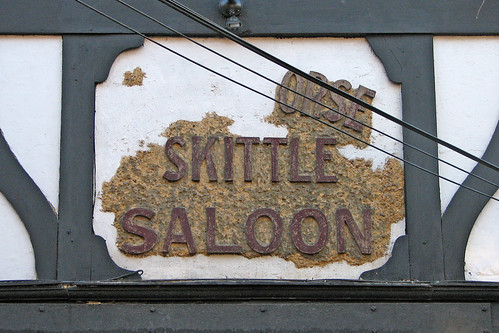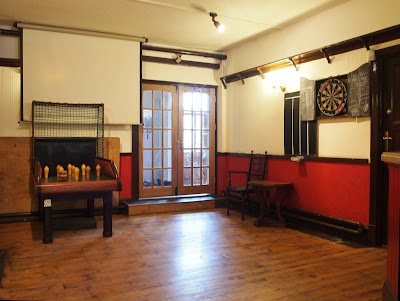 |
| This Image has kindly been made available by Leo Reynolds under a Creative Commons Licence. |
This Skittle Alley is at the Bell Inn, St Johns, Worcester (right). Despite being very busy, the assembled competitors and spectators were happy for me to take a few photographs during a hotly contested Sunday afternoon cup match.
This is a popular and very well used skittle alley, located in an extension at the rear of this unusually laid-out 17th Century locals pub. Well worth a visit when in Worcester.
The pins are of the 'Bristol' type (see below), the white painted ends and stripe on the leading pin is purely to help give players something to aim for. The dark wood of the balls suggests that they are made from Lignum Vitae, preferred by many skittlers over more modern alternatives as they have the correct weight for their size and are very durable. The disadvantage of Lignum balls is that they can reduce the life of both the pins and alley surface.
I've included a picture of the all important 'Sticker-Uppers'. Usually a pair of local lads or family members, employed for the day to put the pins back up and return the balls during a game. You won't find too many Sticker-Uppers in East Midlands skittling, that job is done on a rota basis by the players, but this system is the norm throughout the West Country and West Midlands.
The Skittle Pins shown here are the classic 'Bristol' shape, 10 inches tall and around 4.5 inches across. Bristol pins come in different sizes, and there use is not confined to the Bristol area. These pins originally saw service in a Worcester pub, but they are not the very best quality, which may explain why they've been retired to my ownership whilst still in reasonably good condition. The better quality pins are made from a solid piece of well seasoned Beech or Sycamore, often treated with Linseed oil. The pins shown here are fabricated from several pieces of Beech wood bonded together before being turned and varnished. Whilst they are perfectly adequate for general play, I'm not sure they'd be durable enough for a well used alley like the one at the Bell Inn, particularly if the harder Lignum Vitae or composite balls are preferred. Rubber balls are available which are more suitable for this quality of skittle.
The Dukes Arms in Burton Latimer, Northamptonshire is a sparse, drinkers pub, just the kind of establishment you're likely to find a well used skittles table in the county of Northamptonshire. A brass plate on the front leg indicates that this table has been refurbished by John Tonks in 1998. Note the large sheet of ply wood at the rear of the table, used to protect the glazed doors on the right during play.






No comments:
Post a Comment